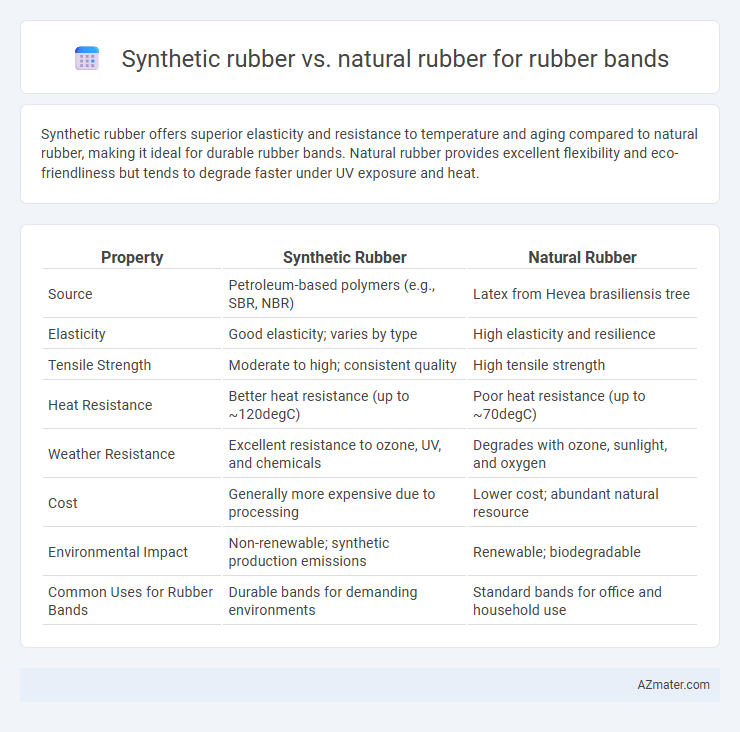Synthetic rubber offers superior elasticity and resistance to temperature and aging compared to natural rubber, making it ideal for durable rubber bands. Natural rubber provides excellent flexibility and eco-friendliness but tends to degrade faster under UV exposure and heat.
Table of Comparison
| Property | Synthetic Rubber | Natural Rubber |
|---|---|---|
| Source | Petroleum-based polymers (e.g., SBR, NBR) | Latex from Hevea brasiliensis tree |
| Elasticity | Good elasticity; varies by type | High elasticity and resilience |
| Tensile Strength | Moderate to high; consistent quality | High tensile strength |
| Heat Resistance | Better heat resistance (up to ~120degC) | Poor heat resistance (up to ~70degC) |
| Weather Resistance | Excellent resistance to ozone, UV, and chemicals | Degrades with ozone, sunlight, and oxygen |
| Cost | Generally more expensive due to processing | Lower cost; abundant natural resource |
| Environmental Impact | Non-renewable; synthetic production emissions | Renewable; biodegradable |
| Common Uses for Rubber Bands | Durable bands for demanding environments | Standard bands for office and household use |
Introduction to Synthetic Rubber and Natural Rubber
Synthetic rubber, derived from petroleum-based monomers such as styrene and butadiene, offers consistent quality and enhanced resistance to heat, oil, and abrasion, making it ideal for manufacturing durable rubber bands. Natural rubber, sourced from the latex of rubber trees (Hevea brasiliensis), provides superior elasticity, resilience, and tensile strength, which contributes to the flexibility and stretchability of traditional rubber bands. Both materials play crucial roles in rubber band production, with synthetic rubber preferred for industrial applications and natural rubber favored for eco-friendly and high-performance uses.
Composition and Source of Synthetic vs Natural Rubber
Natural rubber is composed primarily of cis-1,4-polyisoprene derived from the latex sap of Hevea brasiliensis trees, making it a biodegradable, renewable resource. Synthetic rubber, such as styrene-butadiene rubber (SBR) or neoprene, is produced from petroleum-based monomers through polymerization processes, resulting in materials with enhanced resistance to heat, chemicals, and abrasion. The source difference impacts the elasticity and durability of rubber bands, with natural rubber offering superior elasticity and synthetic alternatives providing improved environmental resistance.
Manufacturing Process Differences
Synthetic rubber used in rubber bands is primarily produced through polymerization of monomers like styrene and butadiene, allowing controlled molecular structure and enhanced uniformity, whereas natural rubber is harvested from latex sap of Hevea brasiliensis trees and processed by coagulation and drying. The synthetic process enables rapid large-scale production with consistent physical properties and resistance to environmental factors, while natural rubber manufacturing involves biological extraction followed by vulcanization to improve elasticity and durability. Variations in raw material sourcing and polymerization or coagulation methods lead to differences in elasticity, strength, and chemical resistance between synthetic and natural rubber elastic bands.
Physical Properties Comparison
Synthetic rubber, such as styrene-butadiene rubber (SBR), exhibits higher abrasion resistance and greater tensile strength compared to natural rubber, making it more durable under repetitive stretching in rubber bands. Natural rubber offers superior elasticity and better resilience, enabling rubber bands to stretch further and recover their original shape more effectively. Temperature resistance is generally better in synthetic rubber, withstanding higher heat without degradation, whereas natural rubber performs well in moderate temperatures but degrades faster under UV exposure and ozone.
Elasticity and Strength in Rubber Bands
Synthetic rubber exhibits superior elasticity and consistent strength compared to natural rubber, making it ideal for rubber bands requiring high stretchability and resilience. Its engineered polymer chains allow synthetic rubber bands to maintain elasticity over extended use and resist deformation under stress. Natural rubber, while biodegradable and flexible, tends to lose strength and elasticity faster due to susceptibility to heat, UV exposure, and oxidation.
Durability and Resistance to Environmental Factors
Synthetic rubber used in rubber bands offers superior durability compared to natural rubber, maintaining elasticity and strength under frequent stretching and harsh conditions. It exhibits enhanced resistance to environmental factors such as UV radiation, ozone, and temperature variations, preventing cracking and degradation. Natural rubber, while flexible and strong initially, tends to degrade faster when exposed to sunlight, heat, and moisture, reducing its lifespan in outdoor or demanding applications.
Cost and Economic Considerations
Synthetic rubber generally offers a more cost-effective solution for rubber bands due to its consistent supply and lower production expenses compared to natural rubber, which relies on agricultural conditions and can face price volatility. Natural rubber, although biodegradable and preferred for applications demanding elasticity and durability, often incurs higher costs due to limited global plantations and processing variability. Economic considerations favor synthetic rubber in large-scale manufacturing, where stable prices and supply chains reduce overall production costs and minimize market risks.
Environmental Impact and Sustainability
Synthetic rubber used in rubber bands is derived from petrochemicals, leading to higher carbon emissions and reliance on non-renewable resources compared to natural rubber, which is harvested from Hevea brasiliensis trees. Natural rubber is biodegradable and supports carbon sequestration, making it a more sustainable choice with a lower environmental footprint. However, synthetic rubber offers superior resistance to degradation, which can reduce waste in specific applications but poses long-term persistence concerns in landfills.
Applications and Industry Preferences
Synthetic rubber offers superior resistance to heat, chemicals, and aging, making it the preferred choice in industrial applications requiring durability and consistent performance, such as automotive and electronics manufacturing. Natural rubber provides excellent elasticity and tensile strength, favored in applications like medical gloves and eco-friendly consumer products due to its biodegradability and comfort. Industry preferences lean towards synthetic rubber for high-performance and long-lasting rubber bands, while natural rubber remains popular in sectors prioritizing environmental sustainability and flexibility.
Choosing the Right Rubber for Rubber Bands
Choosing the right rubber for rubber bands depends on elasticity, durability, and environmental resistance. Synthetic rubber, such as styrene-butadiene or neoprene, offers superior strength and weather resistance, making it ideal for prolonged outdoor use. Natural rubber provides excellent elasticity and tackiness but may degrade faster under UV exposure and ozone, limiting its longevity in harsh conditions.

Infographic: Synthetic rubber vs Natural rubber for Rubber band
 azmater.com
azmater.com